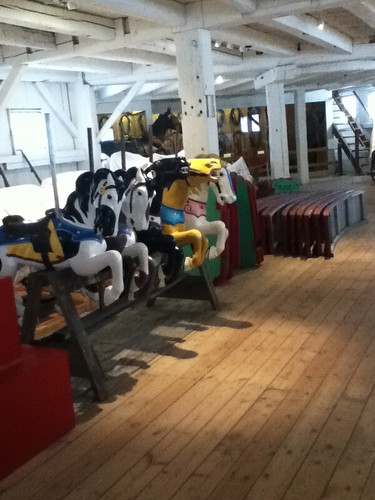I've been working on a fascinating side project that I just have to share. Early last week, I was perusing our records to find objects given to the museum by a specific donor. During my search, I happened to pull out a card with the name and address of someone who made a gift to the museum in the 1960's. This card caught my eye because the address listed a home in my small New Jersey neighborhood, quite close to where I grew up and went to school. Quite the coincidence, right? I was extremely curious as to what this New Jersey resident gave to Shelburne Museum, so I put aside my work for a few minutes and searched for the record for this item.
When I found the card listing the familiar New Jersey address, it gave the accession number "1966-221," which told me the item was accessioned or assigned to the museum's permanent collection in 1966. I immediately went to the book for 1966 to see what the object was. The record read: "Historical photograph of covered bridge with circus lithographs inside. Catalog reference 27.12." Sounds awesome, right? I had to learn more.
Shelburne Museum also has its own completely unique catalog system--this is separate from accession records and is based on groups of objects that go together, i.e., "furniture," "horse-drawn vehicles" and "scrimshaw." The accession record for this item 1966-221 lists the catalog reference for "27.12." That points me in the direction of our historical photograph collection.
Tuesday afternoon, about two minutes before 5, I was just about to close the catalog book I had been looking through and head home for the evening. Then suddenly, I stumbled upon exactly what I wanted to find: my magical mystery photo! Here it is:
Here is a note from the donor that goes with the 1966 record:
 "This photo was taken from inside a covered bridge looking out (unusual) and, at the left posted inside the bridge are two circus lithographs (posters). This photo was made from an old glass negative."
"This photo was taken from inside a covered bridge looking out (unusual) and, at the left posted inside the bridge are two circus lithographs (posters). This photo was made from an old glass negative." You can see why I was so excited--it is an unusual and very unique photo, but it also relates to our collection in numerous ways. We have our very own covered bridge on the grounds (as well as many photos of other examples!) and a very substantial circus poster collection. What an interesting find for the week!
This story gets even better, however. Stay tuned for Part II of the Covered Bridge Circus Saga, coming soon!





